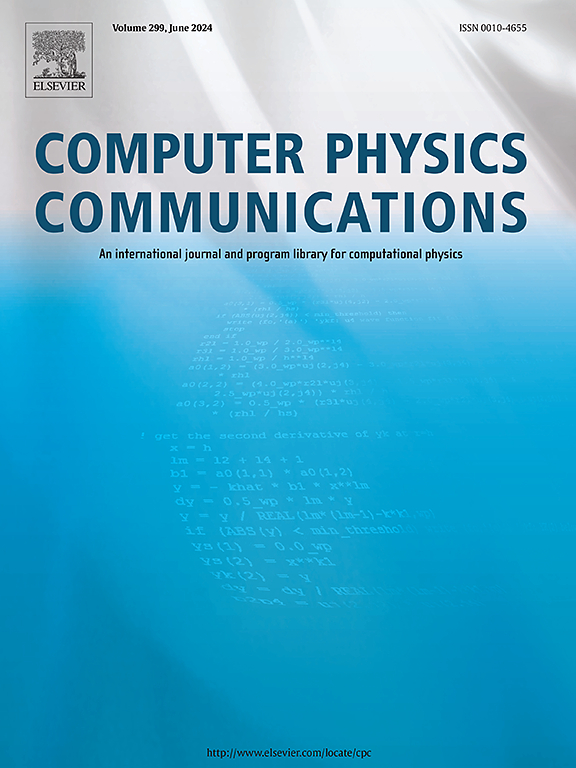A feature-preserving parallel particle generation method for complex geometries
IF 7.2
2区 物理与天体物理
Q1 COMPUTER SCIENCE, INTERDISCIPLINARY APPLICATIONS
引用次数: 0
Abstract
In this paper, a Feature-preserving Particle Generation (FPPG) method for arbitrary complex geometry is proposed. Instead of basing on implicit geometries, such as level-set, FPPG employs an explicit geometric representation for the parallel and automatic generation of high-quality surface and volume particles, which enables the full preservation of geometric features, such as sharp edges, singularities and etc. Several new algorithms are proposed in this paper to achieve the aforementioned objectives. First, a particle mapping and feature line extraction algorithm is proposed to ensure the adequate representation of arbitrary complex geometry. An improved and efficient data structure is developed too to maximize the parallel efficiency and to optimize the memory footprint. Second, the physics-based particle relaxation procedure is tailored for the explicit geometric representation to achieve a uniform particle distribution. Third, in order to handle large-scale industrial models, the proposed FPPG method is entirely parallelized on shared memory systems and Boolean operations are allowed to tackle structures with multiple assemblies. Intensive numerical tests are carried out to demonstrate the capabilities of FPPG. The scalability tests show that a speedup of 10X is achieved through multi-threading parallelization with various models. Comparative studies with other particle generation methods show that FPPG achieves better performance in both runtime and accuracy. Last, two industrial cases of vehicle wading and gearbox oiling are studied to illustrate that FPPG is applicable to complex geometries.
一种特征保持的复杂几何结构平行粒子生成方法
提出了一种适用于任意复杂几何形状的特征保持粒子生成方法。FPPG不是基于隐式几何,如水平集,而是采用显式几何表示来并行和自动生成高质量的表面和体积粒子,从而能够充分保留几何特征,如锐边,奇点等。本文提出了几种新的算法来实现上述目标。首先,提出了一种粒子映射和特征线提取算法,以保证对任意复杂几何图形的充分表示。为了最大限度地提高并行效率和优化内存占用,还开发了一种改进的高效数据结构。其次,基于物理的粒子松弛过程针对显式几何表示进行了定制,以实现均匀的粒子分布。第三,为了处理大规模的工业模型,所提出的FPPG方法在共享内存系统上完全并行化,并且允许布尔运算处理具有多个组件的结构。为了验证FPPG的性能,进行了大量的数值试验。可扩展性测试表明,通过对各种模型进行多线程并行处理,可以实现10倍的速度提升。与其他粒子生成方法的对比研究表明,FPPG在运行时间和精度上都具有更好的性能。最后,通过对车辆涉水和变速箱加油两个工业实例的研究,说明了FPPG适用于复杂几何形状。
本文章由计算机程序翻译,如有差异,请以英文原文为准。
求助全文
约1分钟内获得全文
求助全文
来源期刊

Computer Physics Communications
物理-计算机:跨学科应用
CiteScore
12.10
自引率
3.20%
发文量
287
审稿时长
5.3 months
期刊介绍:
The focus of CPC is on contemporary computational methods and techniques and their implementation, the effectiveness of which will normally be evidenced by the author(s) within the context of a substantive problem in physics. Within this setting CPC publishes two types of paper.
Computer Programs in Physics (CPiP)
These papers describe significant computer programs to be archived in the CPC Program Library which is held in the Mendeley Data repository. The submitted software must be covered by an approved open source licence. Papers and associated computer programs that address a problem of contemporary interest in physics that cannot be solved by current software are particularly encouraged.
Computational Physics Papers (CP)
These are research papers in, but are not limited to, the following themes across computational physics and related disciplines.
mathematical and numerical methods and algorithms;
computational models including those associated with the design, control and analysis of experiments; and
algebraic computation.
Each will normally include software implementation and performance details. The software implementation should, ideally, be available via GitHub, Zenodo or an institutional repository.In addition, research papers on the impact of advanced computer architecture and special purpose computers on computing in the physical sciences and software topics related to, and of importance in, the physical sciences may be considered.
 求助内容:
求助内容: 应助结果提醒方式:
应助结果提醒方式:


